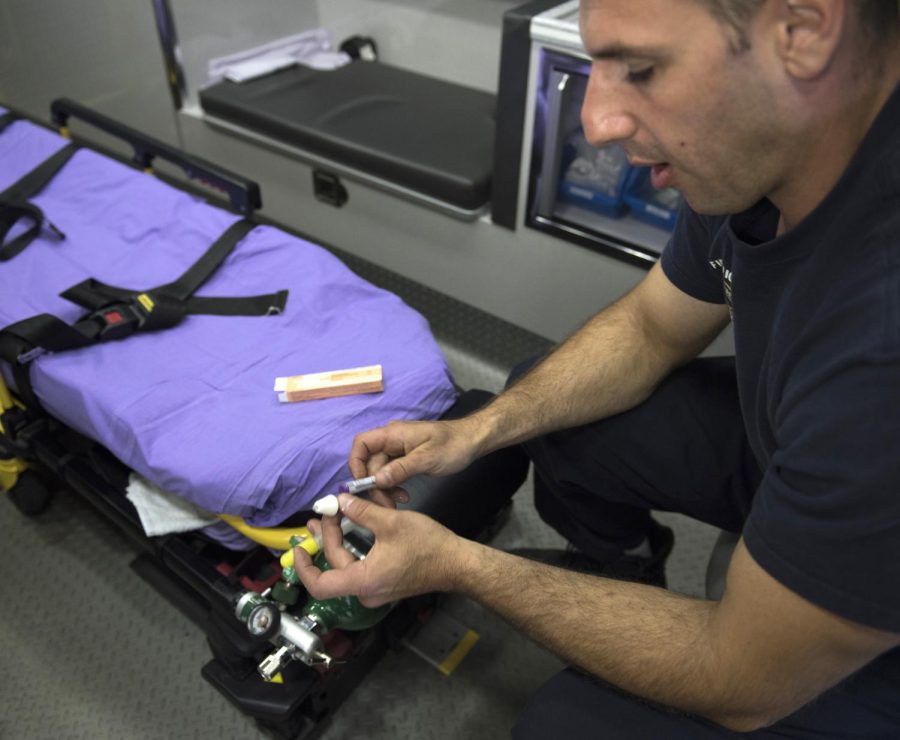EMTs stand the line against heroin overdoses
Jake Robinson, a firefighter/paramedic with the Kent Fire Department, demonstrates how to use Naloxone when confronted with a heroin overdose in the back of an ambulance Tuesday Oct. 18, 2016.
October 18, 2016
As heroin continues to take its toll on victims, families, communities and Portage County law enforcement has taken drastic steps to help combat the nationwide epidemic.
Among other precautions, the county most notably implemented the Portage County Drug Task Force and frequently uses a life-saving antidote called Narcan.
The task force is a multi-agency that includes the Kent Police Department, Portage County Sheriff’s office and surrounding cities’ police departments including Hiram and Ravenna.
In addition to fighting drug use and distribution in Portage County, the task force includes members of the U.S. Drug Enforcement Agency, the Portage County Prosecutor’s Office, the U.S. Department of Homeland Security and the Internal Revenue Service.
Portage County Sheriff David Doak said the task force is a vital agency within Northeast Ohio, and while its primary mission is to fight drugs within the county, it plays a much larger role.
“A great deal of the criminal activity that we see here within the county is fueled by addiction now, and it gets involved with paper crimes, robberies, burglaries … and even including homicides at times,” Doak said.
The influx of drugs — heroin in particular — within Portage County has led to imposing a sales tax to garner revenue. The hope is to expand the Portage County jail due to the overcrowding of drug-related crimes, Doak said.
While drugs remain a problem for county law enforcement, Doak said that heroin-related incidents and deaths have dramatically increased.
“It became very noticeable about five or six years ago when we started seeing this heroin increase, and the death toll of heroin overdoses has far surpassed traffic fatalities in the county,” Doak said.
In 2014, the Food and Drug Administration approved the use of an opioid antidote called naloxone, commonly referred to as “Narcan”.
Narcan works to reverse the effects of the overdose by bringing the victim’s breathing rate back to normal pace. Opioid overdoses cause a person to develop shallow, minimal breaths. It’s this type of drug that allows first responders, like Lt. James Samels, a paramedic and firefighter at the Kent City Fire Department, to help fight against heroin.
“From May 2015 to May 2016, we (Kent Fire Department) administered Narcan 56 times – more than once a week,” Samels said.
As Narcan proves to be the biggest tool that Samels and other first responders use to fight heroin overdoses, there is a lot that has to go right for first responders to administer the antidote successfully, Samels said.
With a successful 49 out of 56 overdoses reversed by Narcan, Samels said he acknowledges the antidote’s importance, but understands the need to treat the disease, not just the symptoms.
“Seven people still died,” he said. “As far as I look at it, that’s 56 times too many in administering Narcan.”
Heroin itself is not the only contributor to the rise in overdoses in Portage County and the nation: Fentanyl is an opiate painkiller used to treat severe pain associated with cancer patients, patients with chronic back pain and hospice patients.
According to Narconon, Fentanyl is 50 times more powerful than heroin. An even more powerful type of fentanyl — known as carfentanil — is up to 100 times more powerful than heroin, and is often used as an animal tranquilizer on large animals such as rhinoceroses and elephants.
Fentanyl has the same consistencies as heroin, and can be almost impossible for a user to differentiate between the two. Wayne Enders, administrator at the Portage County Coroner’s office, said Portage County has had more fentanyl deaths in 2016 than heroin deaths.
Enders believes that Narcan works great on heroin overdoses, but with fentanyl being much more potent, multiple doses could be needed to revive someone.
“Most addicts (who) are often taking heroin … don’t know there is fentanyl laced in the heroin, or they are unaware that they are getting fentanyl and not heroin because the two side-by-side look exactly the same,” Enders said.
Portage County has had 30 heroin and/or fentanyl related deaths last year and a reported 33 in 2016 to date, according to documents obtained from the Portage County Coroner’s office.
Enders has been with the coroner’s office for 20 years. When he started, fentanyl wasn’t something that was on his department’s radar. Now it’s a rampant problem.
“We didn’t see our first fentanyl death until about five years ago,” Enders said. “I didn’t even know what it was until five years ago … all the evidence points toward that the problem is going to get worse.”
Still, Enders said he remains hopeful that with all the agencies in Portage County acting as one, the heroin and fentanyl problem can eventually be minimized.
“We’re all working together to try to alleviate this epidemic that we have,” he said.
Matt Poe is a senior reporter. Contact him at [email protected].












